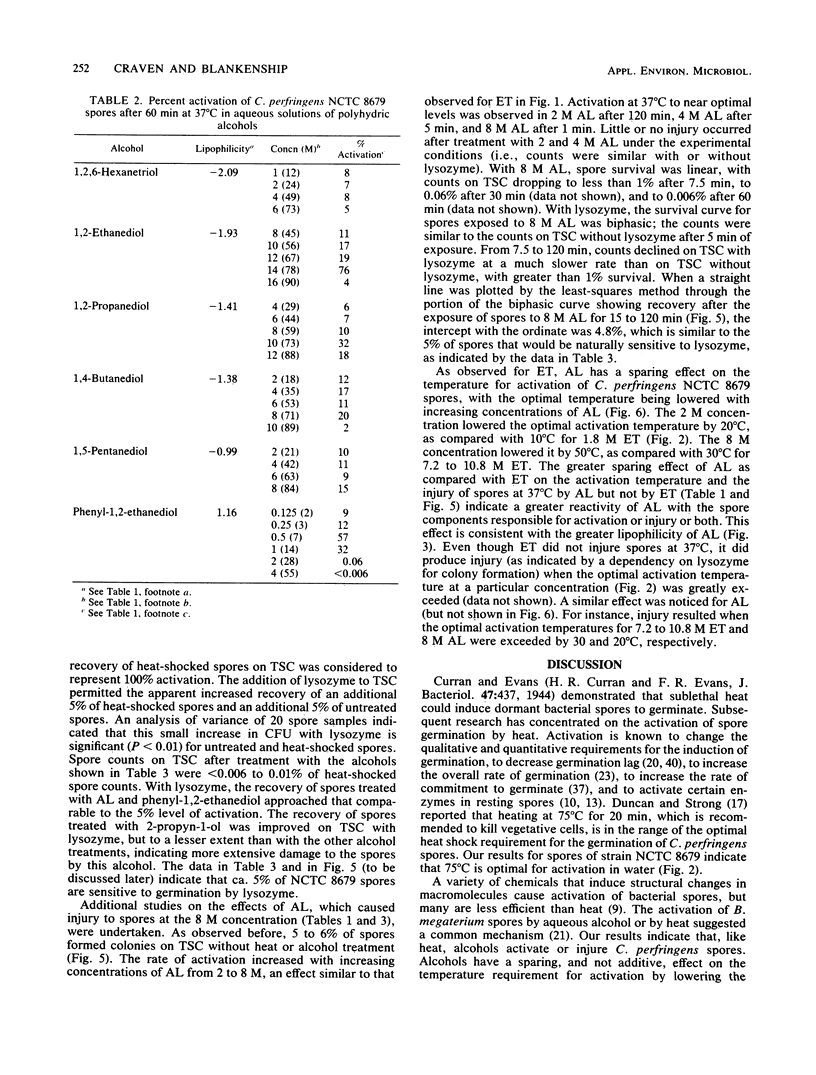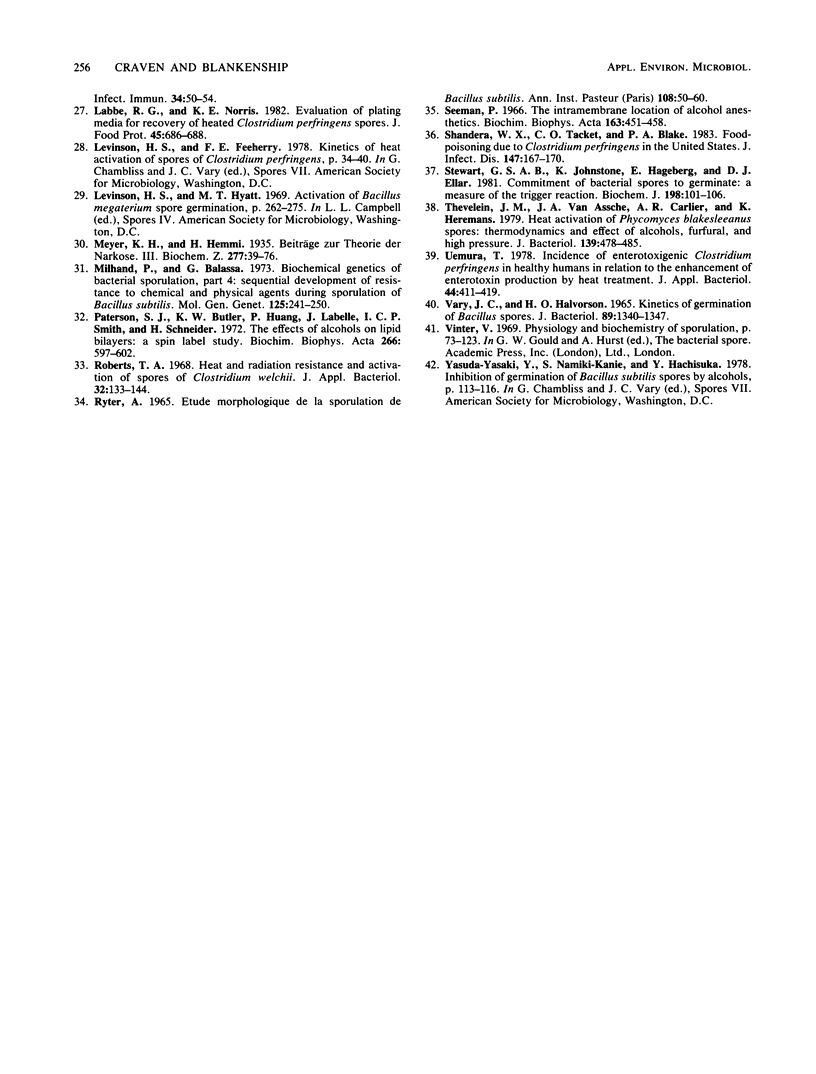Abstract
The activation properties of Clostridium perfringens NCTC 8679 spores were demonstrated by increases in CFU after heating in water or aqueous alcohols. The temperature range for maximum activation, which was 70 to 80 degrees C in water, was lowered by the addition of alcohols. The response at a given temperature was dependent on the time of exposure and the alcohol concentration. The monohydric alcohols and some, but not all, of the polyhydric alcohols could activate spores at 37 degrees C. The concentration of a monohydric alcohol that produced optimal spore activation was inversely related to its lipophilic character. Spore injury, which was manifested as a dependence on lysozyme for germination and colony formation, occurred under some conditions of alcohol treatment that exceeded those for optimal spore activation. Treatment with aqueous solutions of monohydric alcohols effectively activated C. perfringens spores and suggests a hydrophobic site for spore activation.
Full text
PDF







Selected References
These references are in PubMed. This may not be the complete list of references from this article.
- Adams D. M. Heat injury of bacterial spores. Adv Appl Microbiol. 1978;23:245–261. doi: 10.1016/s0065-2164(08)70072-8. [DOI] [PubMed] [Google Scholar]
- Adams D. M. Inactivation of Clostridium perfringens type A spores at ultrahigh temperatures. Appl Microbiol. 1973 Sep;26(3):282–287. doi: 10.1128/am.26.3.282-287.1973. [DOI] [PMC free article] [PubMed] [Google Scholar]
- Adams D. M. Requirement for and sensitivity to lysozyme by Clostridium perfringens spores heated at ultrahigh temperatures. Appl Microbiol. 1974 Apr;27(4):797–801. doi: 10.1128/am.27.4.797-801.1974. [DOI] [PMC free article] [PubMed] [Google Scholar]
- Adams D. M. Sensitization by ethylenediaminetetraacetate of Clostridium perfringens type A spores to germination by lysozyme. J Bacteriol. 1973 Oct;116(1):500–502. doi: 10.1128/jb.116.1.500-502.1973. [DOI] [PMC free article] [PubMed] [Google Scholar]
- Aronson A. I., Fitz-James P. Structure and morphogenesis of the bacterial spore coat. Bacteriol Rev. 1976 Jun;40(2):360–402. doi: 10.1128/br.40.2.360-402.1976. [DOI] [PMC free article] [PubMed] [Google Scholar]
- Barach J. T., Adams D. M., Speck M. L. Recovery of heated Clostridium perfringens type A spores on selective media. Appl Microbiol. 1974 Nov;28(5):793–797. doi: 10.1128/am.28.5.793-797.1974. [DOI] [PMC free article] [PubMed] [Google Scholar]
- Bishop H. L., Doi R. H. Isolation and characterization of ribosomes from Bacillus subtilis spores. J Bacteriol. 1966 Feb;91(2):695–701. doi: 10.1128/jb.91.2.695-701.1966. [DOI] [PMC free article] [PubMed] [Google Scholar]
- Brandts J. F., Hunt L. The thermodynamics of protein denaturation. 3. The denaturation of ribonuclease in water and in aqueous urea and aqueous ethanol mixtures. J Am Chem Soc. 1967 Sep 13;89(19):4826–4838. doi: 10.1021/ja00995a002. [DOI] [PubMed] [Google Scholar]
- CHURCH B. D., HALVORSON H. Intermediate metabolism of aerobic spores. I. Activation of glucose oxidation in spores of Bacillus cereus var terminalis. J Bacteriol. 1957 Apr;73(4):470–476. doi: 10.1128/jb.73.4.470-476.1957. [DOI] [PMC free article] [PubMed] [Google Scholar]
- Cassier M., Ryter A. Sur un mutant de Clostridium perfringens donnant des spores sans tuniques à germination lysozyme-dépendante. Ann Inst Pasteur (Paris) 1971 Dec;121(6):717–732. [PubMed] [Google Scholar]
- Craven S. E., Blankenship L. C. Effect of purine derivatives, papaverine hydrochloride, and imidazole on enterotoxin formation by Clostridium perfringens type A. Can J Microbiol. 1982 Jul;28(7):851–859. doi: 10.1139/m82-127. [DOI] [PubMed] [Google Scholar]
- Duncan C. L., Labbe R. G., Reich R. R. Germination of heat- and alkali-altered spores of Clostridium perfringens type A by lysozyme and an initiation protein. J Bacteriol. 1972 Feb;109(2):550–559. doi: 10.1128/jb.109.2.550-559.1972. [DOI] [PMC free article] [PubMed] [Google Scholar]
- Duncan C. L., Strong D. H. Improved medium for sporulation of Clostridium perfringens. Appl Microbiol. 1968 Jan;16(1):82–89. doi: 10.1128/am.16.1.82-89.1968. [DOI] [PMC free article] [PubMed] [Google Scholar]
- Gutknecht J., Tosteson D. C. Ionic peremability of thin lipid membranes. Effects of n-alkyl alcohols, polyvalent cations, and a secondary amine. J Gen Physiol. 1970 Mar;55(3):359–374. doi: 10.1085/jgp.55.3.359. [DOI] [PMC free article] [PubMed] [Google Scholar]
- Harmon S. M. Collaborative study of an improved method for the enumeration and confirmation of Clostridium perfringens in foods. J Assoc Off Anal Chem. 1976 May;59(3):606–612. [PubMed] [Google Scholar]
- Holmes P. K., Levinson H. S. Activation of Bacillus megaterium spores with aqueous ethyl alcohol; their deactivation and reactivation. Curr Mod Biol. 1967 Nov;1(4):256–258. doi: 10.1016/0303-2647(67)90004-4. [DOI] [PubMed] [Google Scholar]
- Hyatt M. T., Levinson H. S. Water vapor, aqueous ethyl alcohol, and heat activation of Bacillus megaterium spore germination. J Bacteriol. 1968 Jun;95(6):2090–2101. doi: 10.1128/jb.95.6.2090-2101.1968. [DOI] [PMC free article] [PubMed] [Google Scholar]
- Koransky J. R., Allen S. D., Dowell V. R., Jr Use of ethanol for selective isolation of sporeforming microorganisms. Appl Environ Microbiol. 1978 Apr;35(4):762–765. doi: 10.1128/aem.35.4.762-765.1978. [DOI] [PMC free article] [PubMed] [Google Scholar]
- Labbe R. G. Enterotoxin formation by Clostridium perfringens type A in a defined medium. Appl Environ Microbiol. 1981 Jan;41(1):315–317. doi: 10.1128/aem.41.1.315-317.1981. [DOI] [PMC free article] [PubMed] [Google Scholar]
- Milhaud P., Balassa G. Biochemical genetics of bacterial sporulation. IV. Sequential development of resistances to chemical and physical agents during sporulation of Bacillus subtilis. Mol Gen Genet. 1973 Sep 12;125(3):241–250. doi: 10.1007/BF00270746. [DOI] [PubMed] [Google Scholar]
- Paterson S. J., Butler K. W., Huang P., Labelle J., Smith I. C., Schneider H. The effects of alcohols on lipid bilayers: a spin label study. Biochim Biophys Acta. 1972 Jun 20;266(3):597–602. doi: 10.1016/0006-3002(72)90003-0. [DOI] [PubMed] [Google Scholar]
- RYTER A. ETUDE MORPHOLOGIQUE DE LA SPORULATION DE BACILLUS SUBTILIS. Ann Inst Pasteur (Paris) 1965 Jan;108:40–60. [PubMed] [Google Scholar]
- Roberts T. A. Heat and radiation resistance and activation of spores of Clostridium welchii. J Appl Bacteriol. 1968 Mar;31(1):133–144. doi: 10.1111/j.1365-2672.1968.tb00350.x. [DOI] [PubMed] [Google Scholar]
- Shandera W. X., Tacket C. O., Blake P. A. Food poisoning due to Clostridium perfringens in the United States. J Infect Dis. 1983 Jan;147(1):167–170. doi: 10.1093/infdis/147.1.167. [DOI] [PubMed] [Google Scholar]
- Stewart G. S., Johnstone K., Hagelberg E., Ellar D. J. Commitment of bacterial spores to germinate. A measure of the trigger reaction. Biochem J. 1981 Jul 15;198(1):101–106. doi: 10.1042/bj1980101. [DOI] [PMC free article] [PubMed] [Google Scholar]
- Thevelein J. M., Van Assche J. A., Carlier A. R., Heremans K. Heat activation of Phycomyces blakesleeanus spores: theromdynamics and effect of alcohols, furfural, and high pressure. J Bacteriol. 1979 Aug;139(2):478–485. doi: 10.1128/jb.139.2.478-485.1979. [DOI] [PMC free article] [PubMed] [Google Scholar]
- Uemura T. Incidence of enterotoxigenic Clostridium perfringens in healthy humans in relation to the enhancement of enterotoxin production by heat treatment. J Appl Bacteriol. 1978 Jun;44(3):411–419. doi: 10.1111/j.1365-2672.1978.tb00815.x. [DOI] [PubMed] [Google Scholar]
- VARY J. C., HALVORSON H. O. KINETICS OF GERMINATION OF BACILLUS SPORES. J Bacteriol. 1965 May;89:1340–1347. doi: 10.1128/jb.89.5.1340-1347.1965. [DOI] [PMC free article] [PubMed] [Google Scholar]


